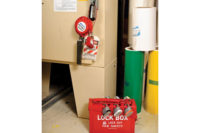Ongoing training
Per the OSHA requirement, training of employees needs to happen annually at the very minimum. Employees should also be retrained anytime there is a change in energy control procedures for equipment or if new equipment is installed. Often near-misses and accidents arise from an employee being unaware or lacking understanding of the change in hazardous energy to a piece of equipment.
For example, you add an additional water line to a chiller. Your maintenance employee has been servicing this same chiller for years knowing there is only one water input. Your employee does not realize that this second input has been added; therefore he does not lock it out during his service, which in turn could result in an accident, increased insurance costs, lost work time and high operating costs.
Some lockout-tagout standards, such as OSHA 29 CFR 1910.147 (The Control of Hazardous Energy for General Industry), OSHA 29CFR 1915.89 (Lockout/Tags-Plus for the Maritime Industry) and OSHA 29 CFR 1926.417 (Lockout and Tagging of Circuit for the Construction Industry), have been in effect for more than 20 years. It still remains the sixth-most frequent citation in the general industry and the ninth-most cited overall OSHA violation.
With this in mind, it is critical to ensure that your employees are informed of the latest technologies, standards and training requirements in order to reduce OSHA citation costs, improve productivity and eliminate injuries.
Understand the equipment
Many new pieces of equipment are being manufactured with built-in lockout features. Whether it’s a ball valve with a built-in sliding lock feature or a disconnect switch with a padlock hole attachment, there are many new ways to lock out a piece of equipment.
Your company policy should clearly state which products are acceptable for locking out certain types of equipment and whether employees should use the built-in feature or apply your visual lockout devices.
Employees also need to be aware of the different varieties and styles of lockout devices, as well as the correct steps to use them. An immense amount of lockout devices are available and certain devices are more effective for specific types of equipment. You must communicate this information and knowledge to employees during your lockout training sessions.
A changing workforce
An additional, yet essential source of undocumented knowledge comes directly from within your facility — your long-term employees.
Over the next few years, the demographics of your workforce will change dramatically. As the baby boomer generation nears retirement, you will face a staggering knowledge loss.
Young employees, though qualified, will lack the experience of using lockout-tagout devices, understanding the proper steps and procedures required during
shift changeovers and what types of products supplement certain equipment. It is critical to your organization’s success to mine the knowledge of your seasoned workers. Utilize their knowledge and embed it in your workplace environment as a form of training for newer employees.
The change in employee demographics also serves as an opportune time to truly enhance the visuals throughout your facility to make procedures clearer and readily available per each machine. The addition of a visual lockout procedure program can reduce error and make the steps within a process easier to understand.
Providing all employees, especially newer employees, with the knowledge that seasoned employees have gained and supplementing it with visuals will enhance and improve your lockout-tagout training and workforce.
But it doesn’t stop there. A variety of training and communication tools are available to continue training and informing your employees.
Utilize training tools
Many companies offer online training services that are accessible directly from a worksite computer 24/7. These training tools usually include videos, demonstrations, quizzes and more. You can also keep your facility up-to-date with visuals, including safety posters, a lockout-tagout procedure station and signs to depict warnings, barricades and other important messaging.
If you really want to enhance your safety program and expand the knowledge of your employees, utilize a third-party service to help your facility. Some companies offer on-site lockout-tagout seminars or facility audits to determine how to improve your current program. Implementing a thorough lockout training program for your facility and employees will not only keep you OSHA compliant, but it will help prevent injuries and accidents, in addition to enhancing the knowledge of your staff and creating a safer workplace.


